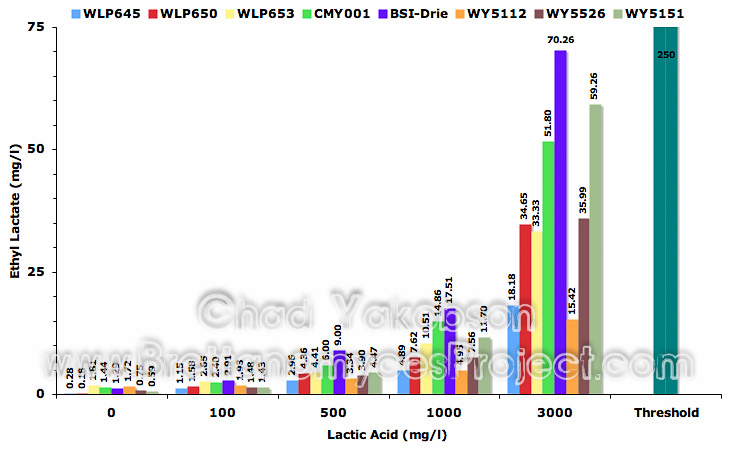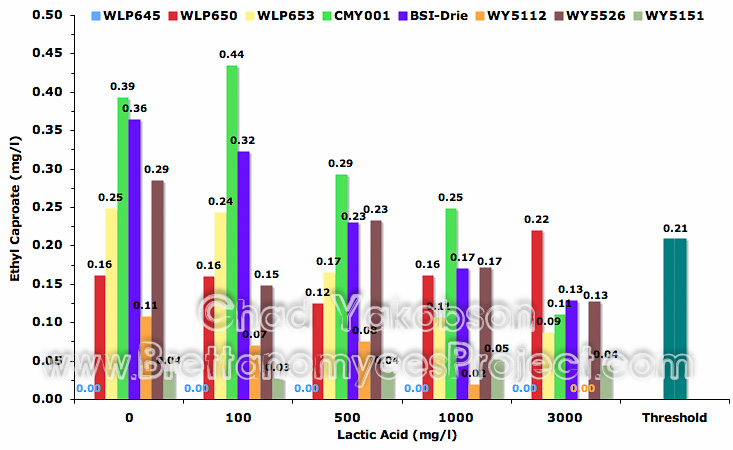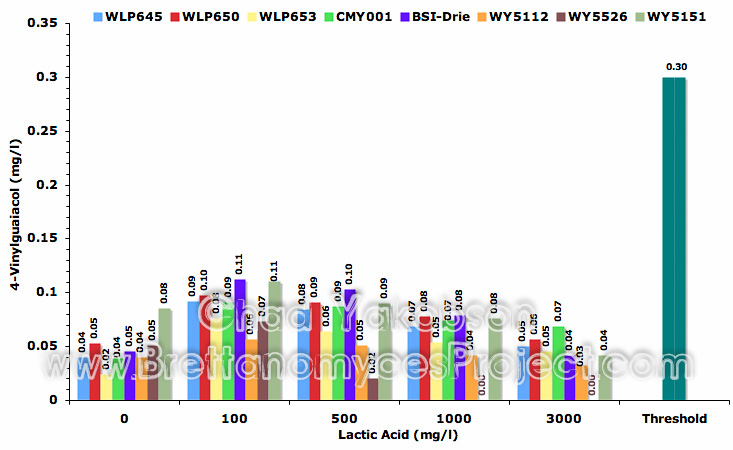Initial Lactic Acid Concentration
Prior to fermentation, wort was acidified with different concentrations of lactic acid (100, 500, 1,000, 3,000 mg/l) to observe the apparent effect it had on eight Brettanomyces strains ability to ferment, using a pitching rate of 12×106 cells/ml. Fermentation data showed an increase in apparent attenuation in every strain with six of the eight strains having their highest attenuation when initial lactic acid concentrations were 3,000 mg/l (Table 5). When observing attenuation levels in fermentations with an initial lactic acid concentration of 3,000 mg/l, there is a significant difference compared to the attenuation levels seen in fermentations without lactic acid. Four strains had apparent attenuation greater than 70%, with two strains achieving attenuation levels of 50% – 70% with an initial of lactic acid concentration of 3,000 mg/l. No strains had an apparent attenuation of 30% – 50%, while two strains finished with below 30%. B. bruxellensis (WY5112) was the only strain to have a higher attenuation at 1,000 mg/l (33.47% ±0.02) and saw a decrease in attenuation of 47.5% compared to the attenuation observed at 3,000 mg/l (17.75% ±0.01). B. lambicus (WLP653) attenuated the best with 100 mg/l (61.03% ±0.1) while attenuation with 3,000 mg/l was 55.28% (±0.0). The most pronounced change in attenuation was with the strains B. lambicus (WY5526) and B. claussenii (WY5151), both of which had greater than 70% attenuation when fermentations initially contained 3,000mg/l of lactic acid. B. claussenii (WY5151) had an overall increase in apparent attenuation of 50.34% when comparing the attenuation of fermentations without lactic acid and fermentations with 3,000 mg/l of lactic acid.
Quantitative Analysis
Fermentations conducted with five different levels of initial lactic acid concentrations produced evident changes in the amount of compounds detected. The initial concentration of lactic acid had a noticeable effect on three esters characteristic to Brettanomyces primary fermentations with a fourth ester, ethyl lactate having the largest change out of all the compounds observed (Fig. 15).

Figure 15. Mean ethyl lactate (mg/l) formed during 35 days of pure culture fermentation with different amounts of lactic acid added to the wort (0, 100, 500, 1,000, 3,000 mg/l). Fermentations were conducted using eight strains of Brettanomyces inoculated at a pitching rate of 12×106 cells/ml.
Ethyl acetate production increased in six of the eight strains as the initial concentration of lactic acid increased (Fig. 16). The only decrease in ethyl acetate was observed in the strain B. bruxellensis (BSI-Drie) when a high of 42.63 mg/l (±2.52) was present in fermentations with initial concentrations of 100 mg/l lactic acid while the production decreased to 27.46 mg/l (±2.58) when initial lactic acid concentrations were increased to 3,000 mg/l. B. bruxellensis (CMY001) produced 2 times more (50.4%) ethyl acetate with a concentration of 1,000 mg/l initial lactic acid compared to fermentations conducted with no initial lactic acid. It was observed at both 1,000 mg/l and 3,000 mg/l ethyl acetate was produced above threshold levels by the strain B. bruxellensis (CMY001). B. bruxellensis (WLP650 & WY5112) and B. claussenii (WLP645 & WY5151) were found to be strains which produced low amounts of ethyl acetate, with the highest level of ethyl acetate observed from B. claussenii (WY5151) at 13.26 mg/l when initial concentrations of lactic acid were 3,000mg/l.

Figure 16. Mean ethyl acetate (mg/l) formed during 35 days of pure culture fermentation with different amounts of lactic acid added to the wort (0, 100, 500, 1,000, 3,000 mg/l). Fermentations were conducted using eight strains of Brettanomyces inoculated at a pitching rate of 12×106 cells/ml.
Production of the ester ethyl caproate decreased as the initial concentration of lactic acid was increased (Fig. 17). All four of the strains that produced ethyl caproate above threshold levels when no lactic acid was present, saw a decrease to below threshold levels as initial lactic acid concentrations were increased. B. bruxellensis (WLP650) was the only strain to have an increase in ethyl caproate, with 0.22mg/l (±0.02) present in fermentations with 3,000 mg/l of lactic acid compared to 0.16 mg/l at concentrations of 0, 100, and 1,000 mg/l of initial lactic acid. B. claussenii (WLP645) had no detectable ethyl caproate present in any of the fermentations conducted during the entire study, while B. claussenii (WY5151) consistently produced a mean value of 0.038 mg/l (±0.009) of ethyl caproate throughout the entire study.

Figure 17. Mean ethyl caproate (mg/l) formed during 35 days of pure culture fermentation with different amounts of lactic acid added to the wort (0, 100, 500, 1,000, 3,000 mg/l). Fermentations were conducted using eight strains of Brettanomyces inoculated at a pitching rate of 12×106 cells/ml.
A general decrease was observed in the compound ethyl caprylate as the initial concentration of lactic acid was increased (Fig. 18). The largest decrease in ethyl caprylate (84.18%) was observed in the strain B. bruxellensis (CMY001). A mean value of 3.35 mg/l (±0.14) of ethyl caprylate was produced in fermentations with no initial lactic acid, while 0.53 mg/l (±0.03) was produced in fermentations with initial lactic acid concentrations of 3,000 mg/l. Further, large decreases were seen in the strains B. bruxellensis (BSI-Drie) and B. lambicus (WLP653) as both strains had decreases of 82% and 76.75% respectively. Both B. claussenii strains (WLP645 & WY5151) were observed to have the lowest production of ethyl caprylate out of the eight strains.

Figure 18. Mean ethyl caprylate (mg/l) formed during 35 days of pure culture fermentation with different amounts of lactic acid added to the wort (0, 100, 500, 1,000, 3,000 mg/l). Fermentations were conducted using eight strains of Brettanomyces inoculated at a pitching rate of 12×106 cells/ml.
No detectable amounts of isoamyl acetate or isobutyl acetate esters were observed in any of the fermentations throughout the entire study. Ethyl butyrate had slightly decreasing, below threshold levels of production throughout the entire study with no detectable amounts found in fermentations conducted with both of the B. claussenii strains (WLP645 & WY5151) and B. bruxellensis strains (WLP650 & WY5112).
Higher alcohols were not observed at levels near threshold throughout the entire study, although changes in quantity were observed depending on the initial concentration of lactic acid. Five strains, B. lambicus (WLP653 & WY5526), B. claussenii (WLP645 & WY5526), and B. bruxellensis (WLP650) had increases in higher alcohols as the initial concentration of lactic acid increased. B. bruxellensis (CMY001) had a decrease in the higher alcohols isobutanol, 2-methylbutanol, and 3-methylbutanol, while an increase in n-propanol was observed. B. bruxellensis (BSI-Drie) had a decrease in all four of the higher alcohols analysed.
An impact on 4-vinylguaiacol production was observed in fermentations with different levels of initial lactic acid concentrations (Fig. 19). The highest level of 4-vinylguaiacol was observed in all eight strains when fermentations contained initial lactic acid concentration of 100 mg/l. The largest concentration of 4-vinylguaiacol was produced by B. bruxellensis (BSI-Drie) (mean value 0.112 mg/l ±0.0007) with the second highest quantity observed in B. claussenii (WY5151) with a mean value of 0.110 mg/l (±0.0009). 4-vinylguaiacol production observed a decrease as initial lactic acid concentration increased from 100 mg/l up to 3,000 mg/l. Fermentations conducted with the strain B. lambicus (WY5526) and having initial lactic acid concentrations of 1,000 mg/l and 3,000 mg/l contained no detectable amounts of 4-vinylguaiacol. Throughout the study the volatile phenolic compound 4-vinylphenol was not detected in any Brettanomyces primary fermentations.

Figure 19. Mean 4-vinylguaiacol (mg/l) formed during 35 days of pure culture fermentation with different amounts of lactic acid added to the wort (0, 100, 500, 1,000, 3,000 mg/l). Fermentations were conducted using eight strains of Brettanomyces inoculated at a pitching rate of 12×106 cells/ml.
Initial lactic acid concentration was not observed to have an effect on diacetyl and 2,3-pentanedione concentrations throughout the study and both compounds were continually observed below threshold values in all eight strains. Acetaldehyde was constantly observed at very low levels throughout the entire study.

